Books by Lisa Frederiksen
10th Anniversary Edition
If You Loved Me, You'd Stop!
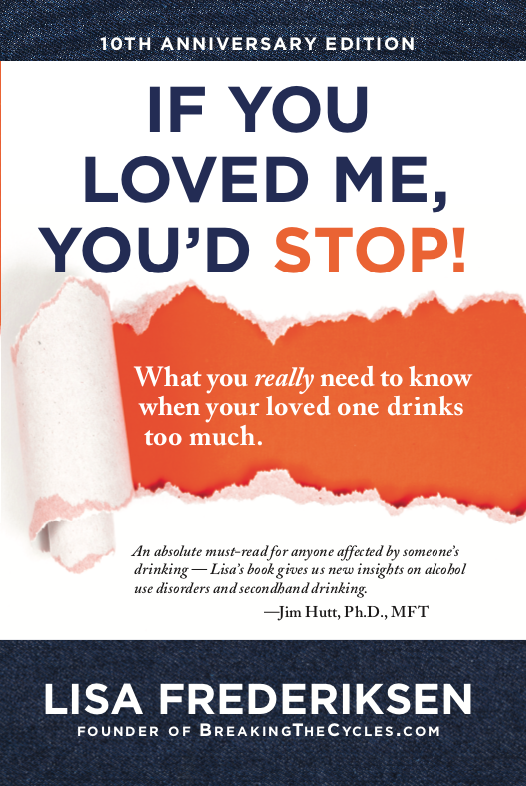
How many times have you screamed "If you loved me, you'd stop!" at your husband or son after a particularly nasty bout of drinking? How many times has your wife or sister promised to cut back; to drink only on special occasions? How many times has your heart been broken when this time turned out to be just like all the times before? If you are one of the nearly 80 million Americans affected by someone's drinking, this book is for you.
This 10th Anniversary Edition includes research advances that explain
- what it is about coping with a loved one's drinking that is so harmful to the family member's physical and emotional health and quality of life
- why alcoholism is a brain disease and what it takes to treat it and why alcoholism is different than alcohol abuse
- what adverse childhood experiences, secondhand drinking, and toxic stress have to do with all of this.
This 10th Anniversary Edition not only shares these important advances in comprehensible language, but it offers suggestions for helping yourself. Because no matter how much you love someone whose drinking affects your life, and no matter how much they love you back, love will not and cannot make them stop.
Additionally, it can help those who struggle with a drinking problem understand what has happened to them and what they can do to change and/or treat it. It can also help family members whose loved ones have an opioid or other drug use disorder.
Educators; treatment and medical professionals; family law practitioners; juvenile and criminal justice professionals; community, business, and public policy leaders and others whose work involves substance use disorders and their impacts on family members, co-workers, and the community-at-large can benefit from reading this book, as well.
"10th Anniversary Edition If You Loved Me, You'd Stop!" is an essential read for understanding the science behind alcohol addiction. You'll discover things about yourself and your loved you didn't realize needed to be discovered. Lisa Frederiksen presents this powerful information in a concise, easy-to-understand way. As an adult child of an alcoholic on a healing journey, I learned more from this book than the dozens of clinical books I've read on the topic. It also provides practical coping and healing tactics for all those who love an alcoholic. "If You Loved Me, You'd Stop!" belongs in the library of all adult children of alcoholics and all those who are worried about a loved one's drinking.
Jody Lamb, adult child of alcoholic and author of “7 Things That Change Everything”
Lisa’s user-friendly book gives the reader hope and a better understanding of how a loved one’s drinking or other drug use disorders turn families upside down and how they may regain their balance.
Carolyn Younger, MFT, Family Program Director Muir Wood Adolescent and Family Services
Lisa Frederiksen’s book, “10th Anniversary Edition If You Loved Me, You’d Stop,” is an excellent resource for families concerned about a loved one's drinking. A thorough explanation of the difference between social drinking, alcohol abuse, and alcoholism and how excessive drinking affects the brain is included. Family members will have a much better understanding of their loved one’s drinking habits not to scold or confront, but rather to work towards finding a recovery process that makes sense for them. Lisa’s coined term, secondhand drinking, so clearly puts into focus what a family member goes through as they navigate the choppy waters of alcohol use disorder. With personal anecdotes, research, and tips on how family members can help themselves, this book is a must-read for anyone struggling with their loved one's excessive drinking.
Cathy Taughinbaugh, Certified Parent Coach, Founder of CathyTaughinbaugh.com
Please read this book. If you have a drinking problem, read the book. If you know or love someone who has a drinking problem, read this book. This book is full of information about alcohol use disorders and secondhand drinking that will help you understand your loved one, as well as yourself. Updated to include the most recent discoveries in brain science and social investigations, it makes clear that it is time to step into recovery and drop the stigma and shame. Truly a "must-read" for anyone in the treatment industry, for the families of those in treatment centers, and for those realizing it isn't "just me."
Kyczy Hawk, Yoga Instructor, Founder of YogaRecovery.com, and Author of “Yoga and the Twelve Step Path,” “Yogic Tools For Recovery,” and a series of word puzzle books combining recovery and yoga.
Quick Guide to Addiction Recovery
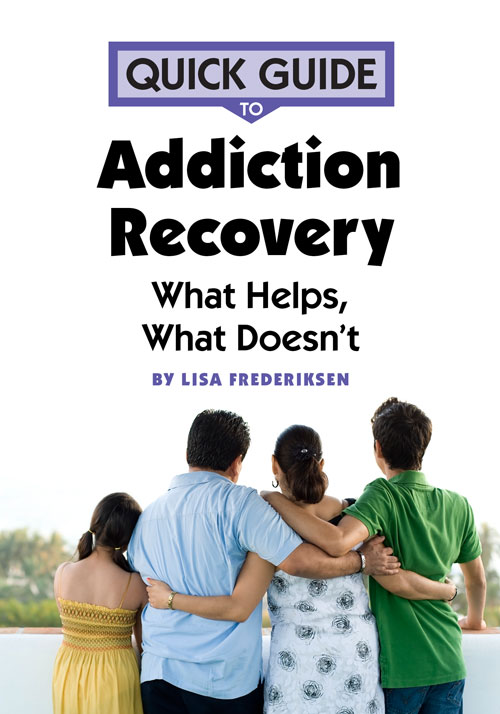
Addiction recovery – what can or should you do to help a loved one get help? Do they have to hit bottom? Should you show “tough love,” or is there another way? How do you know you’re even an alcoholic or drug addict?
So much of what we hear and believe about addiction and addiction recovery is bound up in stigma, misinformation and shame. This fuels age-old beliefs that addiction is a choice and failure to stop is a lack of willpower, a moral weakness. Equally inaccurate is the assumption that relapse means treatment failed or the person didn’t want recovery badly enough.
So what’s changed? How is it possible to define addiction as a brain disease and explain that addiction recovery is all about “healing” the brain? And what is it that helps a person succeed in addiction recovery? What doesn’t? This and more is the subject of my latest Quick Guide. It’s titled Quick Guide to Addiction Recovery: What Helps, What Doesn’t.
As a physician who is board certified in both Emergency Medicine and Addiction Medicine and the Medical Director for an out-patient addiction service, I highly recommend "Quick Guide to Addiction Recovery". The author does a great job of explaining that addiction is a disease of the brain, no different than how diabetes is a disease of the pancreas. How a person develops the disease, what it takes to treat and recover from the disease, as well as what family members can do to help themselves, and through that effort, better help their loved ones is well elucidated. It is a free flowing read with excellent resources linked throughout. I highly recommend it.
Steven Kassels, M.D.
Quick Guide to Secondhand Drinking
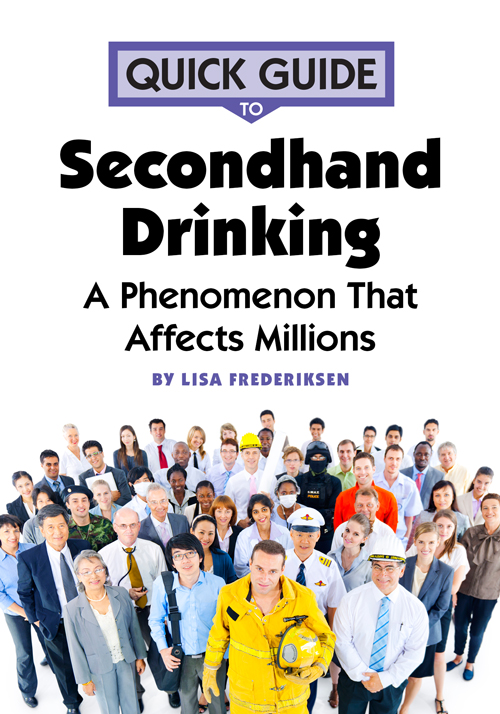
“Secondhand Drinking” – the negative impacts of a person’s drinking behaviors on others – is “A Phenomenon That Affects Millions.”
These behaviors are not intentional. They are not the “real” person coming out, rather they’re the consequence of the chemical in alcoholic beverages changing brain function when alcohol is misused.
The explosion in 21st-century brain research is radically changing our understanding of what happens to the brain when it’s under the influence of alcohol and when it’s on the receiving end of a person’s drinking behaviors. As a result, this science is giving us a new language for talking about a phenomenon that affects 90 million Americans and hundreds of millions more people worldwide. This phenomenon is Secondhand Drinking (SHD).
SHD crosses spectrums from those directly affected by SHD — family members living with someone whose behaviors change when they drink, for example — to a community’s citizens paying the quality-of-life costs and/or tax dollar contributions for law enforcement and criminal justice expenses of alcohol-related crimes.
If you are one of the 91 million Americans affected by secondhand drinking, you need to read this book. Clear, concise and covering all the critical points, the “Quick Guide to Secondhand Drinking,” by Lisa Frederiksen is THE handbook for anyone who loves an addict.
Sandy Swenson, Author of "The Joey Song"
Secondhand Drinking is an important concept that underscores the impact of a practicing alcoholic on family, friends, and co-workers. This little ebook is packed with valuable information about the damage that the stress of living with an alcoholic does to one's nervous system and health. All the science is laid out and tips for self-care. Frederiksen explains why we automatically make excuses for behavior done under-the-influence; yet we would never do the same if it had followed drinking water. The most significant contribution this book makes is to breakdown the denial around someone's drinking, and hopefully get the reader to Al-Anon, as the author suggests. She emphasizes the futility of trying to change an alcoholic, in that alcohol changes the brain, and we can't change an alcoholic's brain when he or she is drinking. Only the consequences of their own drinking may do that. The next steps include detachment and setting boundaries and getting help with codependency.
Darlene Lancer, LMFT, Author of "Codependency for Dummies"
Secondhand Drinking
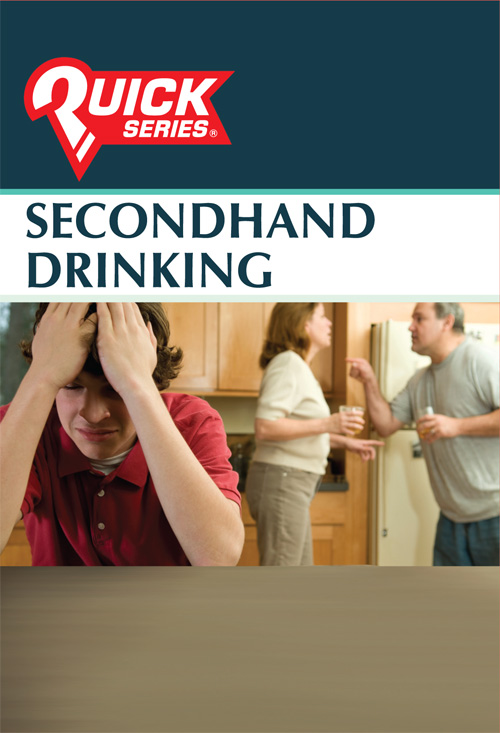
Millions of Americans are affected by secondhand drinking (SHD). This guide covers the causes and consequences of SHD, and proposes solutions, coping strategies and ways to heal.
- SHD defined
- Brain networks and their connection to SHD
- Direct and indirect SHD
- How to protect yourself from the impacts of SHD
Published by Quick Series®, who primarily serve the Military, Veterans, Law Enforcement, Government, Corrections, EMS & Fire and Public Health sectors, this pocket guide covers the causes and consequences of secondhand drinking and proposes solutions, coping strategies and ways to heal.
Crossing the Line

Do you wonder why eating a big meal doesn't keep you from getting drunk? Do you believe coffee will sober a friend up? Do you wonder why some can drink far more than others and still not seem drunk?
In this book, readers will find the latest brain and addiction-related research and science discoveries written for the general public that debunk the common myths about drinking alcohol. Examining and challenging these common myths from a scientific perspective can help readers recognize what it takes to cross the line from alcohol use to abuse to dependence (alcoholism) and what it takes to stop the progression.
...Having a Master's of Science degree in a counseling field that covers rehabilitation counseling, I was very impressed with Crossing the Line from Alcohol Use to Abuse to Dependence. By writing the material in such a concise manner and backing it up with resources, including a link to the author's site, this book is the perfect tool for those who are in need of this information. ...I feel that it will have a huge impact on being able to deal with those who are users and abusers in both my professional life as a college counselor and in my personal life as a human being with friends who have issues.
Paige Lovitt for Reader Views
Once again, Lisa Frederiksen has done what she does best. She has taken an emotionally charged, complex subject riddled with myth and complicated with a myriad of conflicting theories and medical jargon and translated it into a well organized and intelligible synopsis of the alcohol use-abuse-dependence continuum and exposed and shattered the myths along the way. I suspect that if Einstein were alive today he would choose her to transform his theories into language that the masses would be able to easily digest and absorb.
This is the third publication concerning the disease of alcoholism that I have read by Lisa Frederiksen and I am consistently amazed at her gift of communicating her subject matter in a nonjudgemental, compassionate and factual manner. Her data is well researched and current. The reader walks away from the experience enlightened and shameless.
Tim Cheney, Co-Founder and Managing Partner Choopers Guide
Loved One In Treatment? Now What!
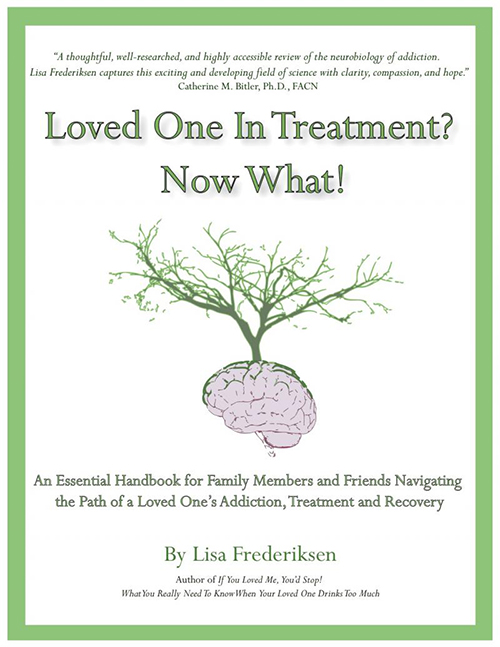
Loved One In Treatment? Now What! offers the first-of-its-kind handbook for family members and friends navigating the path of a loved one’s substance abuse, addiction, treatment and recovery.
By combining the most current brain and addiction-related research with the author’s 40 years experience of coping with family alcoholism and alcohol abuse, this book gives readers the answers they are looking for and helps to ease the pain and confusion that accompany a loved one’s destructive behavior.
What makes Frederiksen’s book especially unique is her explanation of secondhand drinking/drugging (SHDD), namely the impact that one person’s substance misuse can have on others – how it happens, how it can be reversed and how family members and friends can live productive lives, regardless of what their loved one does.
Using easy-to-understand explanations of the latest research and graphically depicting the effect of substance misuse on the brain (thanks to advances in brain imaging technologies), Loved One In Treatment? Now What! answers additional questions, such as: How can addiction be a brain disease? What causes addiction? Why do some people become addicts/alcoholics and others do not? What is "effective" treatment? Is there a difference between treatment and recovery? Who among family members and friends can help a loved one get treatment? Or can they? What does coping with a loved one's addiction do to family members and friends, and what is available to help them?
'Loved One In Treatment? Now What!' is an outstanding, fact-filled, clear, easy-to-read and understand book aimed at helping friends and family, as well as the medical community, comprehend and approach one of the most baffling conditions that we face today.
Stan Fischman, M.D., Child and Adolescent Psychiatry
A thoughtful, well-written, and highly accessible review of the neurobiology of addiction. Lisa Frederiksen captures this exciting and developing field of science with clarity, compassion, and hope.
Catherine M. Bitler, Ph.D., FACN
Ella Baker and the Civil Rights Movement
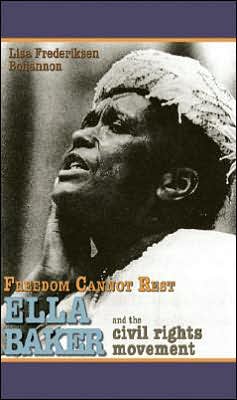
Over the course of her life, Ella Baker helped found scores of organizations, campaigns and coalitions dedicated to the fight for civil rights. Two of the more prominent were the Southern Christian Leadership Conference (SCLC) and the Student Nonviolent Coordinating Committee (SNCC). Her life's story parallels that of the civil rights movement, illustrating the adage that one person can make a difference. Freedom Cannot Rest: Ella Baker and the Civil Rights Movement brings alive some of the most turbulent and dramatic years in our nation's history.
Lisa's work on her biographies on Susan B. Anthony and Elizabeth Cady Stanton exposed her to the 150+ years-long grassroots efforts to secure equal civil rights for African American citizens. This, coupled with research on Septima Poinsetta Clark and Clark's Citizenships Schools and learning that it took the 24th Amendment to the Constitution, ratified in 1964, to remove all legal impediments to African American citizens' right to vote, motivated Lisa to write this biography on Ella Baker - another of the quiet, unsung heroines of the Civil Rights Movement.
Special Recognition:
Named to the 2006 Middle School and 2006 High School California Collections by California Readers, a group of educators, librarians, authors, illustrators, parents, booksellers and business representatives.
...This book is clearly written and amply illustrated with period photos and artwork. In addition to being a compelling biography of Ella Baker, it also provides a concise overview of the Civil Rights Movement, particularly with regard to the various approaches and factions within the movement....
Gerri Gribi, Curator, AfroAmericanHeritage.com, December 2005
[Frederiksen]'s biography joins Joanne Grant's 1998 work on the same subject. Both authors wrote about a life long neglected, but worth telling about. Baker was a major player in the Civil Rights movement of the 1960s. She was the principal organizer of SNCC, the Student Nonviolent Coordinating Committee. A selfless fighter for the rights of black Americans, her achievements have often been overlooked... [Frederiksen] is more objective and makes good use of vintage photographs, artwork, and text boxes that further explain historical events...
Carol Jones Collins, Columbia High School, Maplewood, NJ
School Library Journal, December 2005
Woman's Work - The Story of Betty Friedan
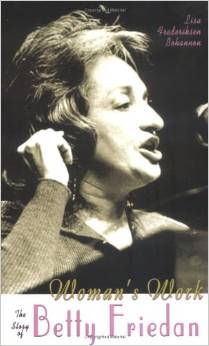
The Feminine Mystique, written by Betty Friedan and published in 1963, was one of the catalyst events launching the modern women's rights movement. This biography presents Friedan's multi-faceted life and work in fascinating detail. Lisa had already published two biographies on early leaders in what's often referred to as the first wave of the women's rights movement and was drawn to Friedan's story and her work as one of the leaders of the second wave.
Special Recognitions:
Named to the Pennsylvania Library Associations' 2004 Young Adult Top 40 Nonfiction Titles List.
Named to the TriState (Pennsylvania, Delaware and New Jersey) 2005 Young Adult Book Review Committee's Books of Note.
Recommendation:
The Horn Book Guide, July-December 2004.
From her early years as a journalist through the publication of The Feminine Mystique to her role in the founding of the National Organization for Women, and her more recent support for seniors’ rights, this title describes Friedan’s considerable influence and significance. The author does a good job of fitting the subject into the context of her time... She does not attempt to glorify but presents a profile of a complex woman with strengths and weaknesses. This is an interesting book that will help teens to understand just how much has changed and how much women have accomplished in the last 50 years...
School Library Journal, November 2004
[Frederiksen] offers a straightforward, unsensationalized biography of her history-making subject. The chapters that follow Friedan chronological through life nicely incorporate relevant cultural and historical background... Throughout, [Frederiksen] balances frankly portrayed, unflattering subject matter with Friedan's extraordinary achievements.
ALA Booklist, January 2005
Failure is Impossible - The Story of Susan B. Anthony
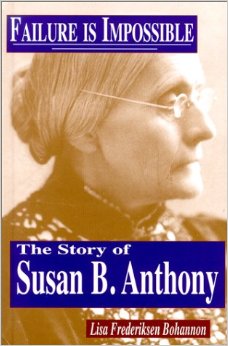
During Lisa's research for her biography on Elizabeth Cady Stanton, she was struck by the fact that Elizabeth and Susan B. Anthony had shared a 50-year friendship and had worked tirelessly together throughout the second half of the 19th Century. Lisa wanted to understand why we knew so much more about Susan than Elizabeth, which led to her writing this biography.
An account of the suffragist's life from her childhood to her death in 1906. Growing up in a large Quaker family during the early part of the 1800s, Anthony assisted her mother with the hard work of running a household. Fortunately, her father strongly believed in equality for women, even starting his own school for his children when the district teacher refused to teach long division to girls. Advanced education and family support enabled Anthony to later lead in the social battles of the day; she tirelessly campaigned for temperance and equal rights for African Americans and women, faced down mobs, and charmed reporters who had wanted to dislike her. [Frederiksen] weaves interesting social detail into her account with mention of bankruptcy, religion, household chores, wages, travel conditions, and convention etiquette. Naturally, there are accounts of collaboration with the important people of the time, from Frederick Douglass to Elizabeth Cady Stanton to Mrs. Horace Greeley (much to Mr. Greeley's chagrin). The author suggests that intelligence and energy persistently applied really do mean "failure is impossible." Black-and-white photographs (primarily portraits) and reproductions are scattered throughout.
School Library Journal, 2001
Born into a nurturing and hard-working Quaker family, Anthony learned to value education and to treat all people with dignity and respect. Swept into the campaign to ban alcohol in an attempt to improve social conditions in America, Susan became disenchanted when she saw that women—who were the heart and soul of the clergy-dominated movement—were denied a voice and a vote at temperance conventions. The experience, however, set the stage for her life-long struggle for women's equality. This concise biography, which takes its title from the reformer's own words, conveys a sense of Anthony's indefatigable spirit and boundless energy. It illuminates the times in which she lived and demonstrates the interrelationship of the temperance, abolitionist and women's suffrage movements. Each chapter contains excerpts from primary source material including letters, diaries and speeches that provide the reader with a glimpse at Anthony's relationships with Elizabeth Cady Stanton, Lucy Stone and Lucretia Mott, among others. The quotes are referenced in a source list which is accompanied by a bibliography and list of related web sites. Part of the "Feminist Voices" series.
Children's Literature, 2001
Women's Rights and Nothing Less - The Story of Elizabeth Cady Stanton
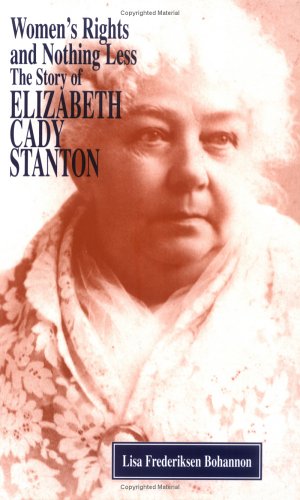
Lisa's interest in women's history was piqued when she came across a document titled, the Declaration of Rights and Sentiments (aka the Declaration of Sentiments and Resolutions) and its history as the rallying cry for the First Women's Rights Convention in Seneca Falls, NY, 1848. She was especially intrigued by the document's key author, Elizabeth Cady Stanton, a woman whom history books mentioned only briefly, if at all, at the time, and yet the first woman to formally call for woman's suffrage.
In this engrossing biography, [Frederiksen] Bohannon paints a vivid picture of a headstrong yet compassionate figure...
ALA Booklist December 1, 2000
This slim, well-written biography describes Stanton's life from her childhood in a conservative, wealthy home in New York...
School Library Journal December 1, 2000
The life of Elizabeth Cady Stanton was devoted to the issue of women's rights. [Frederiksen] makes that clear in her biography, which begins on the first page with one of the most influential experiences of Elizabeth's young life. ...The biography frames the events that shaped Elizabeth's life, her thinking about women, and her work with other influential women leaders of the time, including Lucretia Mott, Susan B. Anthony, and Lucy Stone. Elizabeth's ideas eventually became the most radical of all the women reformers, as she called for more lax divorce laws, married women's property laws and women's suffrage... Overall, a good reference book, complete with photographs, timeline, bibliography, source list, index, and an appendix with the text and background of the nineteenth amendment.
Children's Literature, 2000